-
 Bitcoin
Bitcoin $87,772.6996
0.99% -
 Ethereum
Ethereum $1,570.5330
-2.49% -
 Tether USDt
Tether USDt $1.0000
0.01% -
 XRP
XRP $2.0836
-1.10% -
 BNB
BNB $599.1765
0.07% -
 Solana
Solana $138.0201
-2.11% -
 USDC
USDC $0.9999
0.01% -
 Dogecoin
Dogecoin $0.1599
0.63% -
 TRON
TRON $0.2467
0.31% -
 Cardano
Cardano $0.6233
-1.67% -
 Chainlink
Chainlink $13.1154
-2.78% -
 UNUS SED LEO
UNUS SED LEO $9.1017
-1.66% -
 Avalanche
Avalanche $19.7493
-1.09% -
 Stellar
Stellar $0.2496
0.02% -
 Toncoin
Toncoin $2.9084
-3.65% -
 Shiba Inu
Shiba Inu $0.0...01230
-2.09% -
 Sui
Sui $2.2248
2.27% -
 Hedera
Hedera $0.1694
-0.70% -
 Bitcoin Cash
Bitcoin Cash $342.3982
0.49% -
 Hyperliquid
Hyperliquid $18.1794
-0.12% -
 Litecoin
Litecoin $78.6773
-0.19% -
 Polkadot
Polkadot $3.7586
-4.30% -
 Dai
Dai $0.9998
-0.02% -
 Bitget Token
Bitget Token $4.4381
-1.01% -
 Ethena USDe
Ethena USDe $0.9992
0.01% -
 Pi
Pi $0.6309
-1.94% -
 Monero
Monero $214.9808
-0.07% -
 Uniswap
Uniswap $5.2523
-2.33% -
 Pepe
Pepe $0.0...07838
1.42% -
 OKB
OKB $50.7171
-0.70%
What is a threshold signature in a blockchain?
Threshold signatures enhance blockchain security by distributing signing power among multiple parties, reducing single points of failure and supporting decentralization.
Apr 14, 2025 at 10:14 am
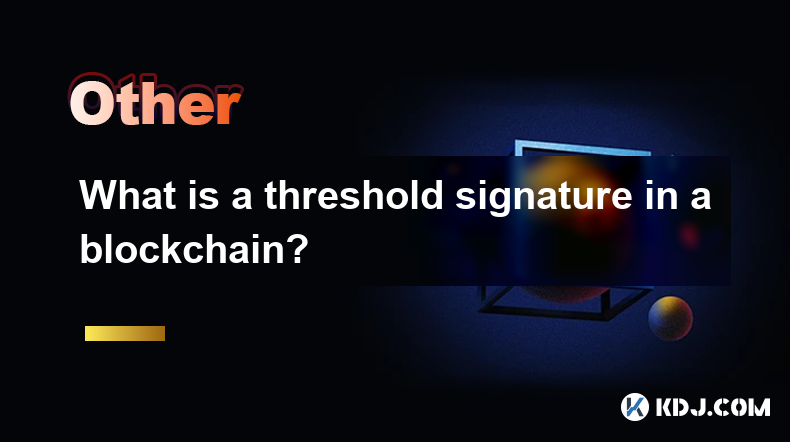
A threshold signature in a blockchain context is a cryptographic technique that allows a group of parties to jointly generate and manage a digital signature. Unlike traditional signatures where a single entity signs a message, a threshold signature scheme requires a predetermined number of participants, known as a threshold, to collaborate and produce a valid signature. This method enhances security and decentralization in blockchain systems by distributing the signing power among multiple entities, reducing the risk of a single point of failure.
How Threshold Signatures Work
In a threshold signature scheme, a group of n participants work together to create a signature. The system is set up so that any subset of at least t participants, where t is the threshold, can generate a valid signature. The key components of this process include:
- Key Generation: Each participant generates a private key share. These shares are used to create a public key that can be used to verify signatures.
- Signature Generation: When a signature is needed, participants use their private key shares to create partial signatures. If at least t participants contribute their partial signatures, these can be combined into a full, valid signature.
- Verification: The resulting signature can be verified using the public key, ensuring that it was generated by at least t participants without revealing who they were.
Applications of Threshold Signatures in Blockchain
Threshold signatures have several applications in blockchain technology, enhancing security and functionality:
- Multi-Signature Wallets: These wallets require multiple signatures to authorize transactions, and threshold signatures can be used to manage the signing process more efficiently.
- Decentralized Governance: In decentralized autonomous organizations (DAOs), threshold signatures can ensure that decisions are made with the consent of a sufficient number of members.
- Secure Multi-Party Computation: Threshold signatures can be used to securely perform computations on private data, ensuring that no single party can access the full data set.
Advantages of Threshold Signatures
The use of threshold signatures in blockchain systems offers several advantages:
- Enhanced Security: By distributing the signing power among multiple parties, the risk of a single compromised key leading to unauthorized transactions is significantly reduced.
- Decentralization: Threshold signatures support the decentralized nature of blockchains by ensuring that no single entity has full control over the signing process.
- Flexibility: The threshold can be adjusted based on the specific needs of the system, allowing for different levels of security and efficiency.
Implementing Threshold Signatures in a Blockchain
To implement threshold signatures in a blockchain, several steps need to be followed:
- Choose a Threshold Signature Scheme: There are various schemes available, such as the BLS (Boneh-Lynn-Shacham) signature scheme or the ECDSA (Elliptic Curve Digital Signature Algorithm) with threshold capabilities.
- Set Up the System: Determine the number of participants (n) and the threshold (t). Each participant needs to generate their private key share and contribute to the creation of the public key.
- Integrate with the Blockchain: Modify the blockchain protocol to include the threshold signature functionality. This involves updating the transaction validation process to accept threshold signatures and integrating the key management system.
- Test and Deploy: Thoroughly test the implementation in a controlled environment before deploying it on the main network. Ensure that the system can handle the expected load and that the threshold signature functionality works as intended.
Challenges and Considerations
While threshold signatures offer significant benefits, there are also challenges and considerations to keep in mind:
- Complexity: Implementing threshold signatures can be complex, requiring a deep understanding of cryptography and distributed systems.
- Performance: The process of generating and verifying threshold signatures can be computationally intensive, potentially impacting the performance of the blockchain.
- Key Management: Managing the private key shares securely is crucial, as any compromise could undermine the security of the system.
FAQs
Q: Can threshold signatures be used with any blockchain?
A: Threshold signatures can be integrated with most blockchains, but the specific implementation may vary depending on the blockchain's architecture and the cryptographic algorithms it supports. It is essential to ensure compatibility and to modify the blockchain's protocol accordingly.
Q: How does the threshold value affect the security of the system?
A: The threshold value (t) determines the minimum number of participants required to generate a valid signature. A higher threshold increases security by making it harder for an attacker to compromise enough participants to create a signature. However, it also increases the complexity and potential delays in the signing process.
Q: What happens if a participant loses their private key share?
A: If a participant loses their private key share, the system can still function as long as the threshold (t) can be met with the remaining participants. However, it is crucial to have a secure backup and recovery process in place to restore the lost key share without compromising the security of the system.
Q: Are there any alternatives to threshold signatures for enhancing blockchain security?
A: Yes, alternatives include multi-signature schemes, where all participants must sign a transaction, and homomorphic encryption, which allows computations on encrypted data. Each method has its own advantages and trade-offs in terms of security, efficiency, and complexity.
Disclaimer:info@kdj.com
The information provided is not trading advice. kdj.com does not assume any responsibility for any investments made based on the information provided in this article. Cryptocurrencies are highly volatile and it is highly recommended that you invest with caution after thorough research!
If you believe that the content used on this website infringes your copyright, please contact us immediately (info@kdj.com) and we will delete it promptly.
- The Next 100x Meme Coin Isn't Even Listed Yet: Trolling the Cat Market
- 2025-04-22 08:40:13
- Pepe Coin (PEPE) Price Prediction: Will the Memecoin Breakout?
- 2025-04-22 08:40:13
- SUI Could Rally 28%, AVAX Bulls Take Control—But Web3 ai's AI Tools Are Built to Outlast Them Both
- 2025-04-22 08:35:13
- Tron (TRX) Emerges as the Top Stablecoin Destination, Bringing in $623 Million
- 2025-04-22 08:35:13
- Apart from cryptocurrencies, NFTs are another popular market
- 2025-04-22 08:30:12
- Top 10 Trending Cryptos on DEXTools in April 2025
- 2025-04-22 08:30:12
Related knowledge

Can ICOs in the blockchain space still make money?
Apr 17,2025 at 08:29pm
The landscape of Initial Coin Offerings (ICOs) in the blockchain space has evolved significantly since their peak in 2017 and 2018. Despite the increased regulatory scrutiny and the rise of alternative fundraising methods like Security Token Offerings (STOs) and Initial Exchange Offerings (IEOs), ICOs can still be a viable way to raise funds and generat...

Can the application of blockchain in supply chain finance bring benefits?
Apr 15,2025 at 04:00pm
Can the application of blockchain in supply chain finance bring benefits? The integration of blockchain technology into supply chain finance has garnered significant attention in the cryptocurrency and financial sectors. This article explores how blockchain can potentially revolutionize supply chain finance, detailing its benefits and providing a compre...
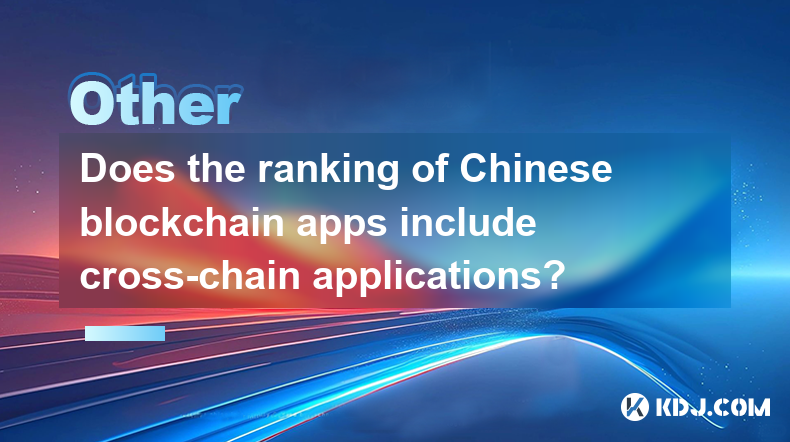
Does the ranking of Chinese blockchain apps include cross-chain applications?
Apr 14,2025 at 04:00pm
The ranking of Chinese blockchain apps is a comprehensive evaluation that takes into account various aspects such as user base, transaction volume, and technological innovation. A pertinent question arises regarding whether these rankings include cross-chain applications. Cross-chain applications, which allow different blockchain networks to interact an...
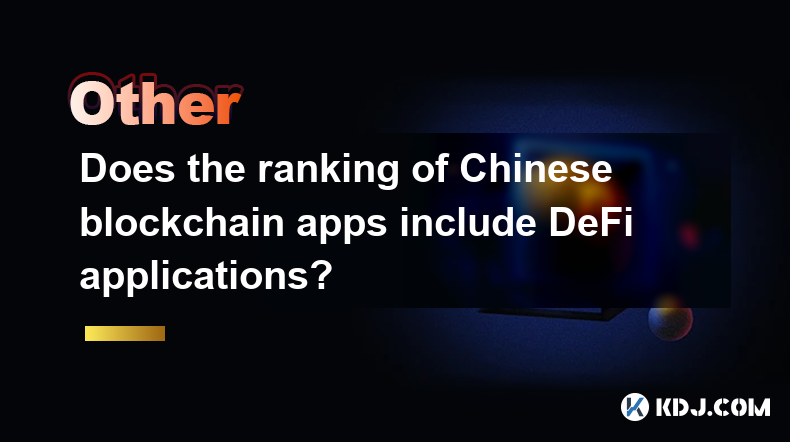
Does the ranking of Chinese blockchain apps include DeFi applications?
Apr 15,2025 at 06:57am
The ranking of Chinese blockchain apps is a comprehensive list that showcases the most popular and influential applications within the cryptocurrency ecosystem. One question that often arises is whether these rankings include DeFi applications. To answer this, we need to delve into the specifics of how these rankings are compiled and what types of appli...
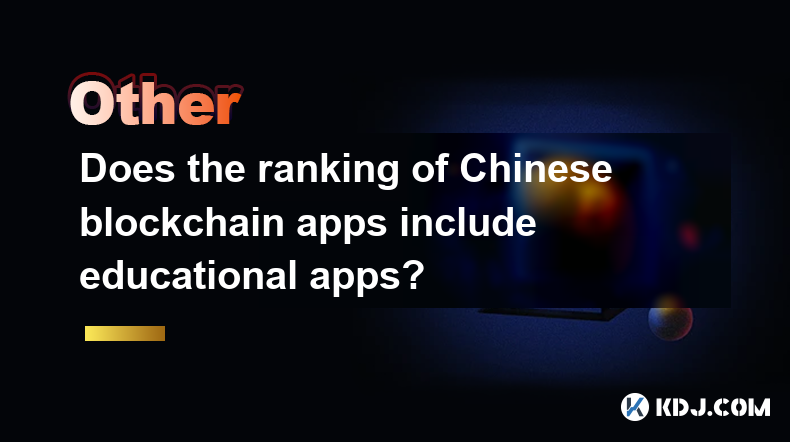
Does the ranking of Chinese blockchain apps include educational apps?
Apr 16,2025 at 03:35am
The ranking of Chinese blockchain apps often includes a variety of categories, from finance and gaming to social networking and beyond. One question that frequently arises is whether these rankings include educational apps. To address this, we need to delve into the specifics of how blockchain apps are categorized and ranked in China, and whether educat...
Does the ranking of Chinese blockchain apps include enterprise-level applications?
Apr 15,2025 at 06:42am
The ranking of Chinese blockchain apps often includes a variety of applications, ranging from consumer-focused to enterprise-level solutions. Understanding the scope and criteria for these rankings is essential to determine if enterprise-level applications are included. This article delves into the specifics of how Chinese blockchain app rankings are co...

Can ICOs in the blockchain space still make money?
Apr 17,2025 at 08:29pm
The landscape of Initial Coin Offerings (ICOs) in the blockchain space has evolved significantly since their peak in 2017 and 2018. Despite the increased regulatory scrutiny and the rise of alternative fundraising methods like Security Token Offerings (STOs) and Initial Exchange Offerings (IEOs), ICOs can still be a viable way to raise funds and generat...

Can the application of blockchain in supply chain finance bring benefits?
Apr 15,2025 at 04:00pm
Can the application of blockchain in supply chain finance bring benefits? The integration of blockchain technology into supply chain finance has garnered significant attention in the cryptocurrency and financial sectors. This article explores how blockchain can potentially revolutionize supply chain finance, detailing its benefits and providing a compre...

Does the ranking of Chinese blockchain apps include cross-chain applications?
Apr 14,2025 at 04:00pm
The ranking of Chinese blockchain apps is a comprehensive evaluation that takes into account various aspects such as user base, transaction volume, and technological innovation. A pertinent question arises regarding whether these rankings include cross-chain applications. Cross-chain applications, which allow different blockchain networks to interact an...

Does the ranking of Chinese blockchain apps include DeFi applications?
Apr 15,2025 at 06:57am
The ranking of Chinese blockchain apps is a comprehensive list that showcases the most popular and influential applications within the cryptocurrency ecosystem. One question that often arises is whether these rankings include DeFi applications. To answer this, we need to delve into the specifics of how these rankings are compiled and what types of appli...

Does the ranking of Chinese blockchain apps include educational apps?
Apr 16,2025 at 03:35am
The ranking of Chinese blockchain apps often includes a variety of categories, from finance and gaming to social networking and beyond. One question that frequently arises is whether these rankings include educational apps. To address this, we need to delve into the specifics of how blockchain apps are categorized and ranked in China, and whether educat...

Does the ranking of Chinese blockchain apps include enterprise-level applications?
Apr 15,2025 at 06:42am
The ranking of Chinese blockchain apps often includes a variety of applications, ranging from consumer-focused to enterprise-level solutions. Understanding the scope and criteria for these rankings is essential to determine if enterprise-level applications are included. This article delves into the specifics of how Chinese blockchain app rankings are co...
See all articles






















































































